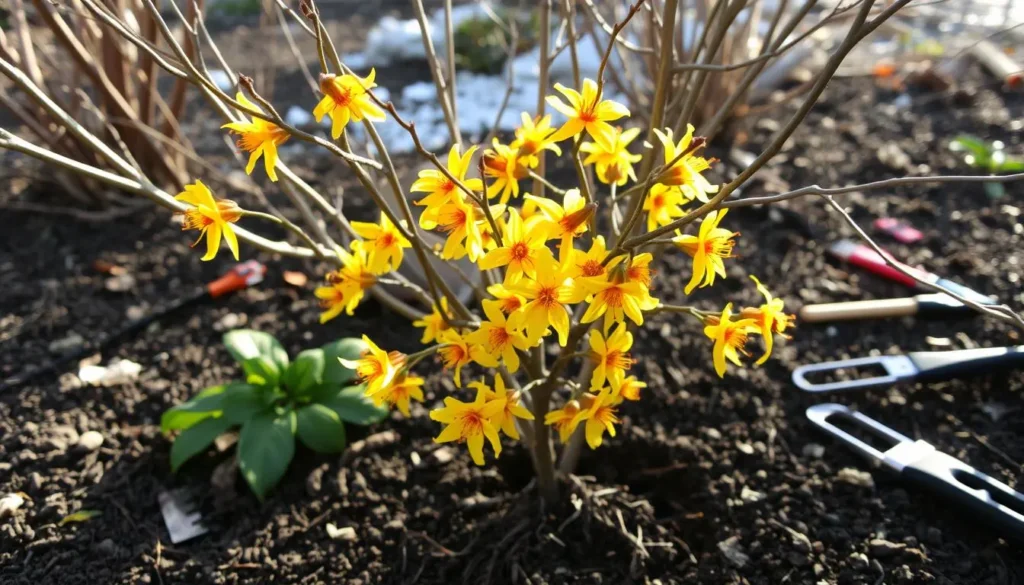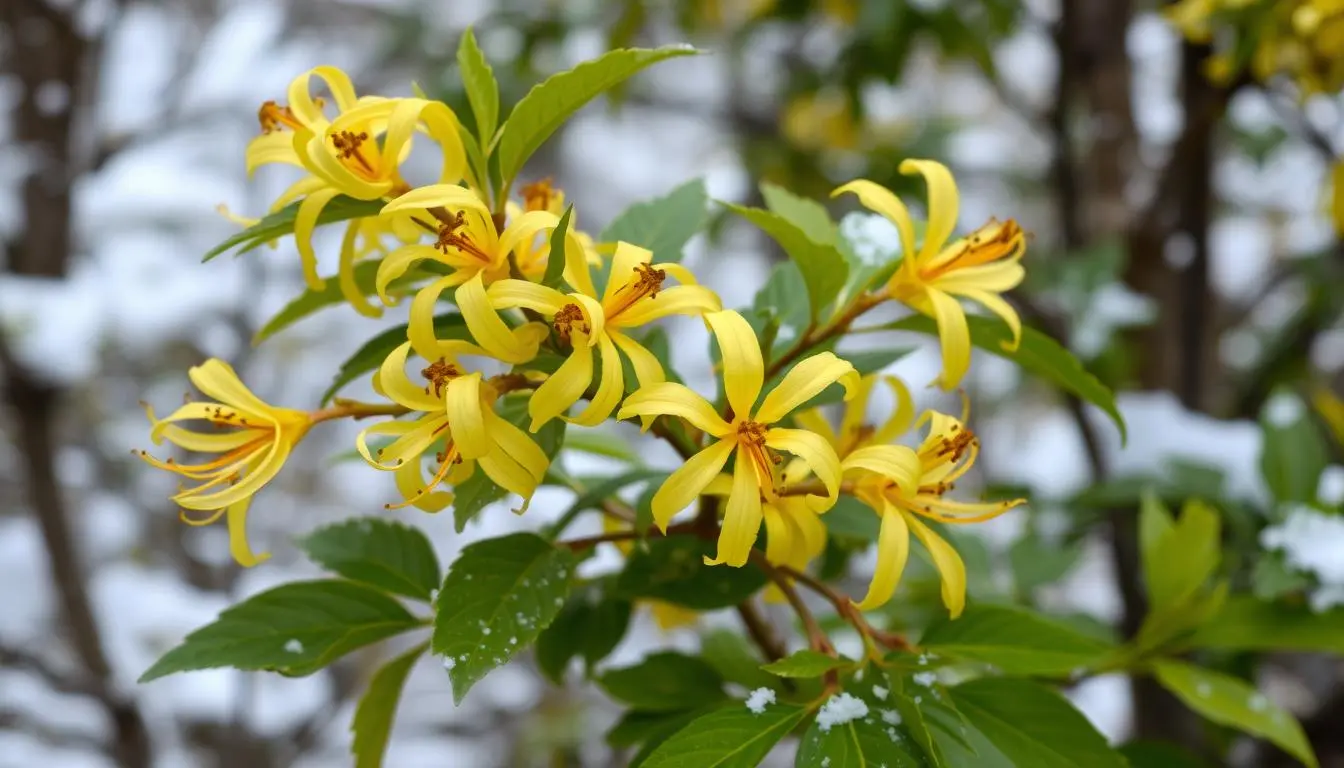Winter’s cold winds bring out a botanical marvel – the witch hazel plant. This shrub blooms with delicate yellow or orange-red flowers, even in the cold. Seeing these flowers fills me with wonder and hope, showing nature’s beauty in winter.
The witch hazel plant is a treasure for gardeners and herbalists. Its beauty and uses are unmatched. This plant will surely captivate and inspire you.
Table of Contents
Understanding the Magic of Witch Hazel Shrubs
Explore the enchanting world of witch hazel shrubs. Here, nature’s magic meets traditional healing. Discover the many native species and special varieties that have been valued for their unique qualities.
Native Species and Varieties
Learn about the two main types of witch hazel shrubs: Hamamelis virginiana and Hamamelis vernalis. Each has its own special traits and ways to adapt. These plants have grown well in different places, from the Appalachian Mountains to the Ozark Plateau.
Historical Significance and Traditional Uses
Discover how Native American communities have used witch hazel for centuries. They valued it for its many uses in medicine and rituals. This tradition has shaped modern herbalism and keeps witch hazel’s special qualities in high regard.
Botanical Characteristics
Find out about witch hazel shrubs’ fascinating features. They have unique leaf shapes, interesting bark textures, and beautiful, fragrant flowers that bloom in winter. Learn about the science behind their adaptations and their importance in nature.
“The witch hazel has long been revered for its unique qualities, from its winter-blooming flowers to its versatile medicinal properties.”
Choosing the Perfect Location for Your Witch Hazel Plant
When growing witch hazel, picking the right spot is key for success. Witch hazel needs a balanced environment. So, choose the best place for your magical shrub.
Think about sunlight. Witch hazel likes partial shade to full sun. It needs 4-6 hours of direct sunlight daily. Don’t plant it in deep shade, as it can affect its growth and blooms.
- Make sure it gets a mix of sun and light shade all day.
- Keep it away from strong, direct sun in the hot summer.
Soil drainage is also vital. Witch hazel grows best in well-drained, acidic soil. Avoid planting in soggy areas to prevent root rot.
- Check your soil’s pH and adjust it to keep it acidic, between 5.0 and 6.5.
- Add compost or peat moss to improve drainage and soil health.
Lastly, find a spot that protects from strong winds. Witch hazel’s delicate parts can get damaged by strong gusts. Plant it near a wall, fence, or other barrier to shield it.
“Choosing the right location is essential for the long-term success of your witch hazel plant.”
By considering these factors, you can create the best spot for your growing witch hazel. This will help it thrive for many years.
Essential Growing Conditions for Successful Cultivation
If you want to grow witch hazel in your garden, knowing the right growing conditions is crucial. We’ll cover soil, light, and water needs. These will help your witch hazel plant stay healthy and bloom beautifully.
Soil Requirements and Preparation
Witch hazel plants like well-draining, slightly acidic soil. The pH should be between 5.5 and 6.5. Adding compost or aged bark can improve the soil. Make sure the area is weed-free before planting your witch hazel.
Light and Temperature Needs
Witch hazel cultivation thrives in partial shade to full sun. They can handle temperatures from -20°F to 95°F. This makes them great for many climates.
Water and Humidity Considerations
Witch hazel plants like moist, well-draining soil but can handle some drought. Water regularly, especially the first year. Keeping the humidity up, especially in dry months, helps too.
By meeting these growing conditions, you’ll grow a healthy witch hazel in your garden.
Planting and Transplanting Guidelines
Planting and transplanting witch hazel can be rewarding. But, it’s key to follow the right steps for your plant to thrive. These guidelines will help you succeed, whether you’re adding a new witch hazel or moving an existing one.
Planting Witch Hazel
Choose a spot with well-drained, acidic soil and partial shade for planting witch hazel. Dig a hole that’s twice the width of the root ball and just as deep. Loosen the roots gently and place the plant in the hole, ensuring the top of the root ball is even with the soil.
Backfill with the original soil, tamp it down, and water thoroughly.
Transplanting Witch Hazel
The best time to transplant witch hazel is in early spring or late fall. Dig a wide, shallow hole around the plant, keeping as much of the root system intact as possible. Carefully lift the plant and replant it in the new location, following the same steps as planting.

Remember, witch hazel grows slowly. Be patient as your plant establishes itself in its new home. With proper care, your witch hazel will thrive and bloom beautifully for years.
Seasonal Care and Maintenance Tips
Keeping your witch hazel plant healthy all year is key. It ensures it blooms beautifully. Let’s look at how to care for it seasonally.
Spring and Summer Care
In spring, start by trimming your witch hazel lightly. This helps it grow and look good. Cut off any dead or damaged parts and thin out the inside to improve air flow.
In summer, make sure your plant gets enough water. Water it extra when it’s dry to keep the soil moist.
Fall Preparations
- Apply a 2-4 inch layer of organic mulch around the base of the plant to insulate the roots and retain moisture.
- Fertilize with a balanced, slow-release fertilizer to provide essential nutrients for the coming year.
- Prune any wayward or overgrown branches to maintain the desired shape and size.
Winter Protection
Witch hazels are tough, but they need a bit of extra care in winter. Wrap the trunk with burlap or tree wrap to protect from frost. If it snows a lot, gently remove snow to avoid broken branches.
By following these witch hazel care and seasonal maintenance tips, your plant will thrive all year. It will bloom beautifully, even when it’s cold outside.
Pruning and Training Your Witch Hazel Bush
Keeping your witch hazel bush healthy and looking good needs the right pruning. Pruning makes your plant look better and helps it grow well. Let’s learn how to care for your witch hazel by pruning and training it right.
Timing is Key
The best time to prune your witch hazel is in late winter or early spring. This is before it starts to bud. It lets the cuts heal and the plant focus on new growth. Don’t prune in summer when it’s growing a lot.
Pruning Tools and Techniques
- Use clean, sharp pruning shears or loppers for clean cuts.
- First, cut off any dead, damaged, or sick branches. Cut them back to a healthy bud or the main stem.
- Thin out crowded branches to improve air and light.
- Prune to shape the plant, removing competing leaders and keeping it balanced and symmetrical.
Remember, the goal is to prune wisely, leaving a healthy framework for the witch hazel bush to thrive.
Training for Desired Forms
Witch hazel bushes can be shaped into different forms, like multi-stemmed plants or single-trunked trees. Use flexible branches and ties to gently guide the plant’s growth. This helps it grow into the shape you want over time.
“The true essence of gardening lies in the art of coaxing nature to reveal its hidden beauty.” – Unknown
By using these pruning and training methods, you can keep your witch hazel bush healthy and looking great. With a bit of care and attention, this winter-blooming beauty will keep you amazed for years.

Common Problems and Solutions
Witch hazel is a vibrant and hardy plant. It can face a few challenges over time. But, with the right care, you can solve these problems and keep your witch hazel tree healthy and beautiful. Let’s look at some common issues and how to fix them.
Disease Prevention and Treatment
Witch hazel trees might get diseases like leaf spot and powdery mildew. To stop these, make sure there’s good air flow around the plant. Don’t overcrowd it. If diseases show up, take off the bad leaves right away. You might also need to use a fungicide made for witch hazel plant health.
Pest Management Strategies
Spider mites and scale insects might bother witch hazel. Keep an eye on your plant and deal with pests fast. Using horticultural oil or insecticidal soap can fight these witch hazel tree problems without hurting the plant.
Growth Issues and Remedies
- If your witch hazel grows slowly or looks stunted, it might be because of bad soil or not enough sunlight. Add compost to the soil and make sure it gets at least 6 hours of direct sunlight a day.
- Leaf drop can happen naturally, but too much might mean the plant is stressed. Make sure it’s getting enough water. Also, protect it from harsh winter weather to keep it healthy.
“Proactive care and prompt attention to any problems can help ensure your witch hazel thrives for years to come.”
By tackling witch hazel tree problems and keeping the growing conditions right, you can enjoy its beautiful blooms and unique leaves for many seasons.
Propagation Methods and Techniques
Learn the magic of your garden by propagating witch hazel! Whether you’re new or experienced, learning witch hazel propagation opens new doors. We’ll cover sowing seeds, layering, and grafting to grow your own witch hazel shrubs.
Seed Sowing
Seed sowing is a simple way to start. Collect seeds in fall, stratify them winter, and sow in spring. It may take two years for them to grow. With the right care, you’ll enjoy your own growing witch hazel plants.
Layering
Layering is another good method. Bend a branch down, secure it, and watch roots grow. Once strong, cut it and move it to a new spot. This way, you can easily grow your favorite witch hazel.
Grafting
Grafting is for the more advanced. It involves attaching a stem cutting to a rootstock. This creates a new plant that’s genetically the same. It needs careful timing but can be very rewarding.
“Witch hazel is a true winter wonder, with its delicate and fragrant flowers blooming even amidst the harshest conditions. Propagating this plant is a rewarding journey that allows you to share the magic with your garden and beyond.”
Patience and detail are crucial in propagating witch hazel. With the right techniques, you’ll grow a beautiful collection of these plants.
Companion Planting and Landscape Design
Witch hazel opens up magical possibilities for garden design. It fits well into many garden styles, bringing winter charm to your outdoor area.
Best Companion Plants
Witch hazel grows best with other hardy plants that interest you in winter. Pair it with evergreen shrubs like hollies and viburnums for a lush look. Hellebores, echinacea, and Russian sage are also great choices, creating a beautiful mix.
Design Ideas for Gardens
Witch hazel’s unique shape and fall colors make it versatile. Use it in a mixed border to stand out. For a formal look, place it as a centerpiece in a shrub garden. Its size is perfect for small gardens or city spaces.
Creating Winter Interest
Witch hazel brings beauty to gardens in winter. Place it near windows or seating to enjoy its blooms. Combine it with plants like Camellia sasanqua or Mahonia for a stunning winter scene.
With the right plants and design, witch hazel can make your garden a year-round treasure.
Conclusion
The witch hazel plant is a winter wonder that brings beauty all year. It has captivating blossoms and many uses in the garden. This shrub is perfect for anyone wanting to beautify their outdoor space.
Knowing how to care for witch hazel ensures your plants stay healthy. This lets you enjoy their scent and colors even in cold weather. Whether you have one plant or many, witch hazel will be a highlight in your garden.
Adding the witch hazel plant to your garden is a great idea. Its beauty in winter and adaptability make it a valuable addition. It promises to bring joy and magic to your garden for many years.

